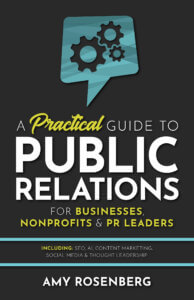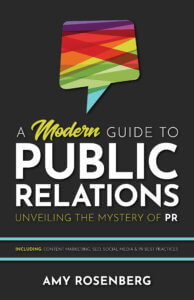On May 25, 2020, George Floyd was killed while in police custody, sparking racial justice protests across the country. Many organizations responded to these events with commitments to advance their own diversity, equity and inclusion (DEI) initiatives. Now, more than three years later, business leaders should assume that their stakeholders will be checking in on the progress of those promises.
Earlier this year, I spoke with two DEI experts on the PR Talk Podcast: Dr. Felicia Blow, APR, Associate Vice President for Development at Hampton University, and Neil Foote, President and CEO of Foote Communications and president of the National Black Public Relations Society. Both spoke about the inherent challenges of DEI work and how communications professionals can play a critical role in advancing this important cause.
Check out those episodes if you’re a business leader struggling to move your DEI promises forward. You may also consider approaching the work through the communications framework, outlined below.
Using a 5-Step Communication System to Build Accountability
First, it’s important to remember that while DEI is all of a sudden popular to talk about, the struggles marginalized people have faced in the workplace are not new. DEI work involves addressing generational harm, and it’s okay to be intimidated by the enormity of that task. What’s not okay is to use the size of the job as an excuse for not taking action. After all, you don’t have to solve this problem all at once. It’s okay to set small goals to get started.
It’s easy for goals to fall by the wayside if you keep them to yourself. That’s why simply communicating your desired outcomes to others helps create the accountability you need to move forward. In a DEI context, sharing your goals, progress and failures with people inside or outside your leadership structure can make a difference. Here’s a five-step system you can follow to progress DEI and establish the accountability needed to make a difference.
Step 1: Pause, Reflect and Research
Professional communicators understand the importance of words, which is why everything they share has been carefully vetted for accuracy and meaning. The same should be true for your DEI efforts. After all, it will be more impactful if your actions are slow, considered and authentic rather than simply saying what you think people want to hear.
Additionally, if you find yourself worrying about making mistakes or saying the wrong thing, that’s a sign you appreciate the importance of this complicated work. So, when in doubt, take it slow and wait to share your goals or action steps until you’re sure they authentically represent your intentions.
Step 2: Promote the Cause, Not the Company
Attempting to market DEI efforts in the corporate world can be dismissed as performative and opportunistic. To combat this cynicism, organizations should always promote the cause over their own interests. When businesses place the cause at the center of their communications, they use their established credibility to move those efforts forward and serve as role models for other organizations searching for ways to make a difference. However, doing this effectively requires humility and seeking counsel from outside experts.
Step 3: Stop Thinking and Get Started
Of course, nothing will change if you don’t take action. Unfortunately, the scope of the problem often keeps organizations on the sidelines. However, even small steps can begin moving you on a more significant path. A few effective places to start could be:
-
- Inventorying your organization’s current diversity position.
- Seeking external help from a DEI consultant. They can help interpret your current position, set realistic goals for making changes and provide advice on how to get there.
- Setting goals and benchmarks for advancing your diversity position in meaningful ways with impacted groups.
- Recording all the actions you take. This action will form the basis of your communications strategy.
- Reporting these steps to your internal stakeholders to build transparency and accountability.
Step 4: Adhere to a Schedule
It’s easy for DEI work to be overshadowed by the organization’s work. That’s why it’s critical to build a schedule for discussing DEI initiatives internally and communicating progress to key stakeholders. This cadence will be different for every organization. Some might form a DEI committee and hold monthly meetings, while others might include DEI objectives in weekly leadership meetings.
Once you’ve established how to talk about DEI work, create a schedule for communicating progress to your internal groups. These updates could happen through employee newsletters, all-hands meetings, dedicated DEI reports or another system that suits your organization. What’s most important is building a process in which DEI is discussed and documented consistently and predictably.
Step 5: Move Some Internal Discussions External
As you begin to make progress internally on your DEI efforts, it’s time to start communicating your work to external audiences. This process could begin simply with blog posts and newsletters. If your organization regularly announces run-of-the-mill news like winning key partnerships or opening new offices, you can include DEI efforts in those posts.
Eventually, you can expand your external DEI advancements by including them in social media, on your website or as press releases you actively pitch. Reporting on your work publicly will begin building the internal and external accountability that will fuel your continued efforts.
Reporting Builds Accountability
Many business leaders are understandably reluctant to publicize their company’s DEI efforts. They might believe that promoting the work cheapens it or that they’ll be judged for not hitting the goals they set. In reality, reporting your work builds accountability because it creates an incentive to follow through on your promises. Reporting also builds credibility with your internal staff because it demonstrates a commitment to transparency throughout the process. These reports also don’t always have to be positive. Sometimes the message of “we’re not meeting our goals” is the most authentic way of communicating that you take DEI work seriously.
However, effective reporting requires a few key elements. You need to set benchmarks to judge where you are and record your actions as you move towards a larger goal. It’s also critical to include a communications professional in the reporting process so they can see what you’ve accomplished and create plans for sharing it effectively.
Regardless of your goals and progress, talking about DEI efforts publicly also gives the issue more publicity, which helps propel the broader movement forward beyond your own efforts.
Keep the Promises You Made
We want to believe that the promises made during the heat of the 2020 racial justice protests were earnest and authentic. However, the old saying actions speak louder than words certainly rings true here. Your organization will be judged on what it does (or doesn’t do), so building a system that encourages activity is crucial for progressing your DEI efforts. Moreover, communicating these efforts publicly, when appropriate, will help promote the larger goals of DEI while creating accountability for your actions and results.
DEI is an Ongoing Process
When done correctly, DEI is an ongoing practice rather than a journey with a final destination. It’s the never-ending process of bringing all workplace groups more equally into the fold. Honestly engaging in this process is making progress. Even admitting that you haven’t started the process is progress. What matters most is bringing these efforts into the light so your team and customers can see that your promises are worth keeping.









